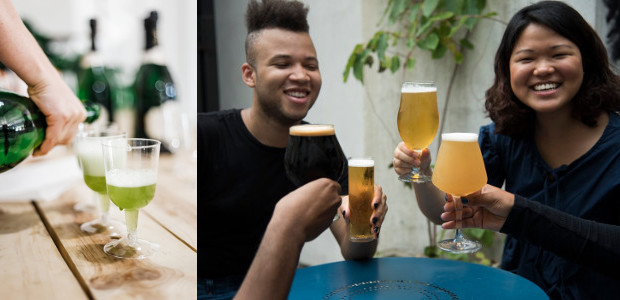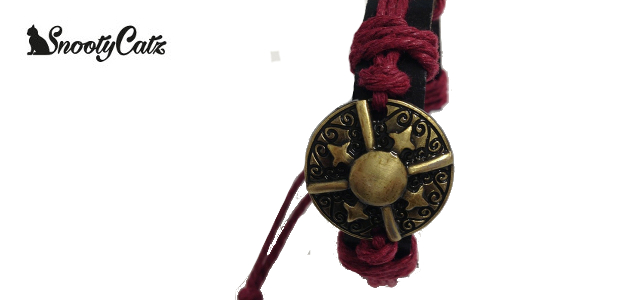Paxton & Whitfield’s Taste of Ireland Cheese Selection Perfect for St. Patrick’s Day
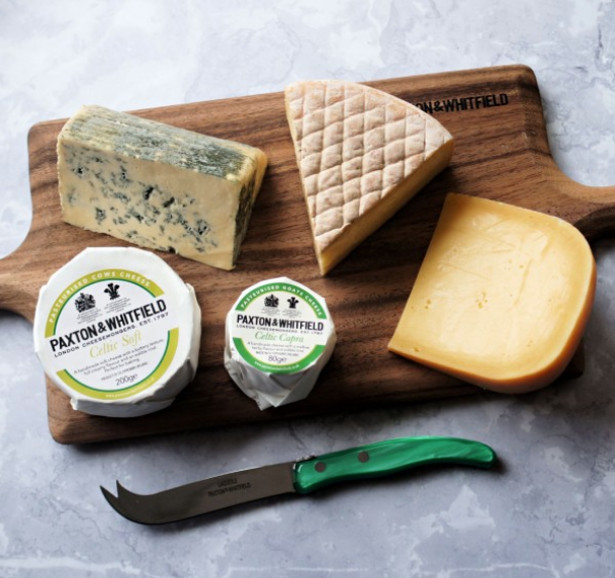
Let Paxton & Whitfield, the UK’s oldest cheesemonger, help you celebrate St. Patrick’s Day on Tuesday 17th March with its Taste of Ireland Cheese Selection (£30.00).
Featuring a selection of five delicious artisan cheeses made by dedicated cheesemakers from across the Emerald Isle, it’s a readymade cheeseboard celebrating Irish cheese and Ireland’s patron saint.
The selection is available from Paxton & Whitfield’s four shops: Jermyn Street, Piccadilly; Cale Street, Chelsea Green; Bath; and Stratford upon Avon, as well as online at www.paxtonandwhitfield.co.uk.
Taste of Ireland Cheese Selection (£30.00) DIRECT LINK: www.paxtonandwhitfield.co.uk/shop/cheese-board-selections/taste-of-ireland?number=230
Celtic Capra (80g) (Pasteurised, vegetarian rennet) Ireland is renowned for its lush green fields and clean air, and in County Tipperary where Celtic Capra is made, the pastures are rich. The grass is full of clover and the soil is peaty, making it the perfect environment to produce the top quality milk needed to make fantastic cheeses. Paxton & Whitfield’s Celtic Capra cheese is a great example of what the area can produce and is made on a farm which uses milk from a neighbouring goat herd. Cornish Capra has a crumbly texture which, with age, develops to a creamier consistency towards the rind. It has fresh, nutty taste from the rind, and a more citrus flavour coming from the paste.
Celtic Soft (200g) (Pasteurised, vegetarian rennet) Again, made in County Tipperary, Paxton & Whitfield’s Celtic Soft cheese is made on a farm which uses milk from its own herd of pedigree Friesian cows. Celtic Soft retains a slight chalkiness in its centre when younger, surrounded by a softer, buttery paste. As it ages, the centre also softens, allowing the entire cheese to reach a melting, creamy consistency. The cheese has distinct hints of mushroom coming from its white rind, and a full, buttery flavour which leaves a long aftertaste. The cheese is fantastic when baked in a cheese baker, or delicious wrapped in puff pastry and cooked in an oven.
Cashel Blue (250g) (Pasteurised, vegetarian rennet) Made by Jane and Louis Grubb near Cashel in Country Tipperary, this semi-soft blue cheese was first produced in 1984. It is a unique cheese as it was Ireland’s first farmhouse blue cheese. In order to make the cheese Jane and Louis researched the Irish cheese market and on finding that no one made a cheese of this style, produced a soft blue cheese – creating their own niche in the cheese market. Although some milk is purchased to make the cheese, the majority comes from the Friesian dairy herd on the farm. Once the curds have been made, they are then placed by hand into cheese moulds but are not pressed. Each of the cheeses is then pierced with stainless steel needles to let the blue mould grow. They are then stored on their sides on timber cradles at 10 degrees until they are two weeks old, which gives the blue mould time to develop inside the cheeses. They are then taken out of the moulds, washed by hand in brine, dried and then wrapped in foil and stored at four degrees until matured. The cheese has a firm texture that takes on a soft, almost spreadable texture as it ages. It has a mellow, subtle and creamy flavour.
Gubbeen (250g) (Pasteurised, vegetarian rennet) A semi-hard, washed rind Irish cheese made from a mixture of pasteurised Friesian and Jersey cows’ milk to produce a supple cheese with a lingering flavour of herbs and burnt caramel. The cheese is made by the Ferguson family at Gubbeen House, on the coast of Schull, West Cork, Ireland. They have been making the cheese since 1979 and use a traditional cheesemaking process. Over a three-week period, the cheese is cured by daily washing and turning which encourages the growth of surface bacteria, giving the cheese its characteristic pale, pinky-brown crust. It has a slightly sweet and soft lingering flavour that grows after the initial taste. It’s not too strong and tastes of fresh milk with a springy texture in its body. With its mellow flavour and slight edge, it could almost be described as an Irish Reblochon.
Mossfield (250g) (Pasteurised, vegetarian rennet) This gouda style cheese is made from organic cows’ milk at Mossfield Farm, County Offaly, Southern Ireland. The milk used to make the cheese comes from a herd of 70 Friesian cows that graze on the herby, tangy pastures found on the farm’s 240 acres. The cheese is rich in colour with a full, nutty flavour that you would expect from Gouda combined with the flavours of the Mossfield grass. As it ages the cheese becomes harder and crumblier with a more intense flavour.
Irish Stew
From the Regional Recipes series by printmaker Kate Guy…

Celebrate St Patrick’s Day on Tuesday 17th March…
From the Regional Recipes series, printmaker Kate Guy has conveniently assembled and illustrated all the ingredients you need to make a traditional, tasty Irish Stew and captured them in her lino print recipe kitchen textiles range.
The large print on this illustrated tea towel is made of individual ‘ingredient’ linocut prints which, combined together, make this complete easy-to-follow recipe – the perfect way to mark St Patrick’s Day!
The ingredients of lamb, onions, carrots, potatoes, stock, bay leaves, thyme, bouquet garni, olive oil and spring onions to garnish are pictured with the iconic Dunluce Castle on the Antrim coast of Northern Ireland.
Chopped and combined together, the ingredients make this complete easy-to-follow recipe – cooking instructions are also included on the back of the packaging if you need any help!
The tea towels are made from organic cotton, very absorbent, hard-wearing and fully machine washable at 40 degrees, you’ll be able to breeze through the drying up once you’ve created and enjoyed your culinary creation!
The tea towels (£12.00 each) are presented with a paper ‘belly band’ which has the cooking instructions for the recipe on the back…..
Irish Stew lino cut illustrated recipe greeting card by Kate Guy
The Irish Stew design is also available as a Greeting Card which, as with the tea towel, features the cooking instructions making them the perfect pressie for food lovers!
Available from www.kateguy.co.uk
Illustrated recipe te towels from Kate Guy
Other designs in the Regional Recipes series include Welsh Cawl and Scotch Broth
About Kate Guy…
Artist and designer Kate Guy has combined her love of printmaking with a love of food and cooking to create a range of signature homewares featuring the strong graphic qualities of lino-cut and screen printing.
Taking as her ethos for the business the quote by William Morris “Have nothing in your house that you do not know to be useful, or believe to be beautiful”, Kate has created her ‘Regional Recipes’ and ‘Simple Soups’ series of illustrated recipes which are then transferred to textile and graphic designs on a range of items for the kitchen and home.
Drawing on influences from her home in North West London and the Languedoc region of South West France which she visits regularly, Kate’s key inspiration is from food and the kitchen;
“I feel that the kitchen is the true heart of the home and the smells and tastes that can be found in this social hub are prominent in my work.”
“Each design begins as a drawing inspired by my surroundings, I work in a sketchbook, keeping it as a visual diary and I also take lots of photographs. I use these as inspiration for my prints; I create linocut blocks which I hand-print, and sometimes paint with watercolour. These prints are then further developed into a range of themed kitchenware, prints and stationery.”
See the full range at www.kateguy.co.uk
Instagram @kate_guy_
Twitter @kate_guy_

CELEBRATE ONE OF THE MOST DELiCIOUS DAYS OF THE YEAR WITH ROBERTS’ Flippin’ Good Bread Pancakes
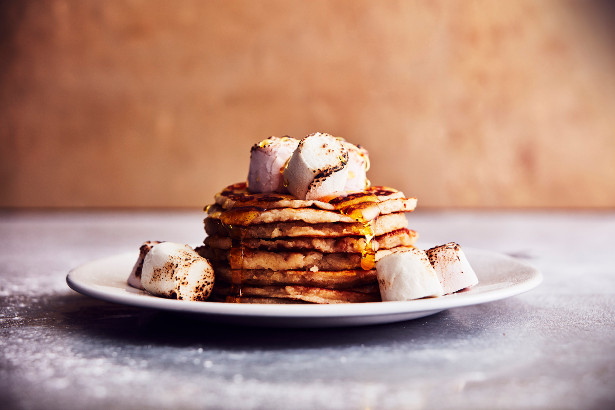
Adding a tasty new twist on the traditional pancake, check out this flippin’ good bread-inspired recipe for a totally tremendous Shrove Tuesday.
Made using milk-soaked breadcrumbs – and sweetened with honey and melted butter – they’re delicious served sugary or savoury with your favourite toppings.
Time to make – preparation 10 minutes and cooking time 3 to 5 minutes each
Serves 6 pancakes
Suitable for vegetarians
We recommend using sliced white bread
You’ll need
1 ½ cups of milk
1 ½ cups of white breadcrumbs
½ cup of flour
2 tsp baking powder
1 egg
2 tbsp of honey
1 tbsp of melted butter
How to make them
Place the breadcrumbs in a mixing bowl. Then pour hot, steaming milk over the top and give it 15 minutes to soak in properly.
Sieve the flour and baking powder into your crumby mixture. Smash an egg into the middle, along with your honey and melted butter. Then blitz ‘til smooth – nobody likes a lumpy pancake.
Spoon some of the batter into a well-buttered frying pan. Leave to sizzle ‘til golden brown, then flip.
Serve with lemon and sugar, or banana and chocolate spread, or cheese and ham, or all of the above! Whatever takes your fancy.
Full details of this dish – along with lots more recipe inspiration – can be found at www.robertsbakery.co.uk/recipe-inspiration.
For St Patrick’s Day ideas check pout these baking recipes from AO Life to give a go for the occasion.
www.ao.com/life
Guinness Chocolate Pudding
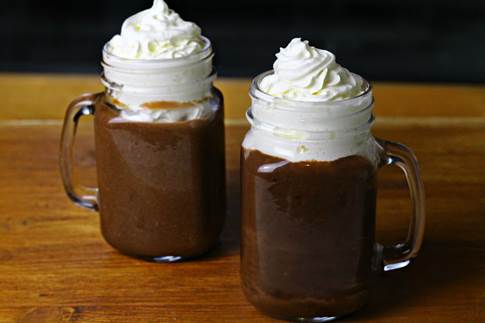
Chocolate Orange & Irish Cream Tiramisu
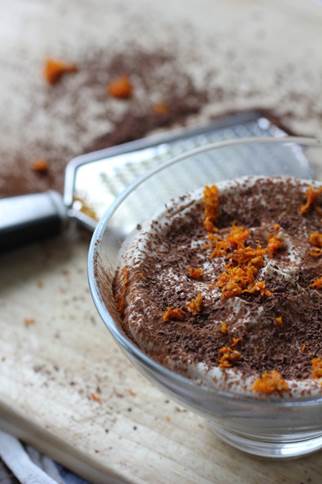
Irish Cream Cookies for St Patrick’s Day

St Patrick’s Day Traditions from Around The World
Here are a few places from around the world, where they do things a little differently on St Patrick’s Day.

By Steph Koyfman, senior content producer at Babbel.
For such a nominally Irish holiday, St. Patrick’s Day is one of the most international occasions of the year. On March 17 each year, rivers and landmarks turn green across the US, UK, China, Australia, Cairo, Prague, Italy, France, Brazil, Vilnius, and Dubai. Though it’s touted as a celebration of Irish national pride, St. Patrick’s Day traditions are for anyone who feels like sporting a little green.
Saint Patrick himself wasn’t Irish, but perhaps that’s fitting for the most widely celebrated national holiday — even in places where there aren’t big Irish populations. Saint Patrick is believed to actually be British, but he became a priest after he was kidnapped and brought to Ireland as a slave. Today, he is revered as the Patron Saint of Ireland for bringing Christianity to the country. Supposedly, he also drove all the snakes out of Ireland, which is awfully convenient for him considering Ireland never had snakes to begin with. (It’s more than likely that the “snakes” were a metaphor for pagans and non-believers.)
Initially, St. Patrick’s Day was a religious feast that didn’t involve consuming copious amounts of booze, but it’s evolved into a generalized celebration of all things “Irish,” especially if debauchery counts in your book. It was actually Irish emigrants (especially those who settled in the United States) who made it into the secular holiday we know today. The first St. Patrick’s Day parade in Boston was held in 1737, and in 1762, New York City followed suit.
And by the way, if you want to stay true to the legacy of this holiday, “St. Paddy’s Day” is the correct abbreviation — not “St. Patty’s Day.” “Patrick” comes from the Gaelic name Pádraig.
Strange St. Patrick’s Day Traditions In The United States
1. New London, Wisconsin
In New London, leprechauns crawl around the city and change all the signs to “New Dublin” for the day — even on the highway. Apparently, this tradition stems from the wave of Irish immigration that fundamentally altered New London’s previously German cultural profile in the 19th century. The leprechauns (members of the local Shamrock Club) go on to visit hospitals and schools. The parade also includes a staged adaptation of Finnegan’s Wake.
2. Portland, Maine
Talk about a rude awakening: the Paddy’s Day Plunge of Portland, Maine, involves jumping into the freezing Atlantic Ocean at 5:30 a.m. Those who braved the early alarm and the frigid waters then enjoy a free Irish breakfast, a live auction and a raffle at a nearby restaurant. It’s also for a good cause (and not just adrenaline): The event donates proceeds to charity.
3. New Orleans, Louisiana
No one throws a parade like New Orleans. And on St. Patrick’s Day, the city flocks down to the Irish Channel neighbourhood for a veritable street party. New Orleans might be the only place where you can take part in a vegetable food fight too. Think: all the ingredients that go in Irish stew (especially cabbages), minus the beef. This ceremonial throwing of the cabbages (using an underhanded technique, so no one gets hurt) is meant to memorialize how cabbage replaced potatoes during the potato famine, thus becoming a staple of Irish cuisine.
4. Chicago, Illinois
Of all the cities that dye their waterways or landmarks green for St. Paddy’s Day (and there are many), Chicago’s green river is the most famous. Every year, the Chicago River turns green in time for a parade held on the closest Saturday to the holiday. This tradition has been guarded by the Butler and Rowan families for more than 50 years. A six-person boat crew (family only) distributes a top-secret recipe that contains eco-friendly, vegetable-based dye into the river, casting a spell on the waterway that can last for a few days.
5. Hot Springs, Arkansas
Hot Springs is the home of the world’s shortest St. Patrick’s Day Parade, which takes place on “The Shortest Street in Everyday Use in the World,” as it was named by Ripley’s Believe It Or Not in the 1940s. Bridge Street, which is only 98 feet long, hosts the hour-long parade, which includes Elvis impersonators, a Blarney Stone kissing contest and various other performances.
Unusual St. Patrick’s Day Traditions In The Rest Of The World
6. Montserrat
This Caribbean island, home to a sizeable Irish Catholic population since the 17th century, is the only place in the world outside of Ireland where St. Patrick’s Day is a public holiday. Montserrat’s celebration isn’t just generously proportioned — it lasts for 10 days! In addition to celebrating the saint, the day also commemorates a slave rebellion and includes a calypso competition and Creole food, blending the island’s Irish and African heritage.
7. Brussels, Belgium
Along with a traditional parade, Brussels residents play Irish sports such as Gaelic football, hurling and camogie on March 17. And if you feel like dusting off your sports attire later and cleaning up, head to the black-tie St. Patrick’s Day Ball, where you can toast during a champagne reception. It’s unclear whether the champagne is green or not, however.
8. Banwen, Wales
This Welsh city has laid claim to being St. Patrick’s birthplace, and they ritualize it annually. According to members of the Banwen & District History Club in Wales, St. Patrick was born in Banwen in the year 385 AD as Maewyn Succat. Their parade culminates at a stone commemorating the saint’s alleged birthplace.
9. International Space Station
How “international” are we talking here? Because apparently, St. Patrick’s Day isn’t only earthbound. In 2013, a Canadian astronaut wore green, took a photo of Ireland from space and posted a video of him singing “Danny Boy.” This builds on the precedent of another astronaut who performed an Irish flute song in space to commemorate St. Patrick’s Day.
10. Ise, Japan
One of Japan’s St. Patrick’s Day parades kicks off at the Ise Shrine, which is dedicated to a Shinto sun goddess. With the Japanese and Irish flags flying together, residents dress like leprechauns, play bagpipes and do jigs. The day culminates with an oyster festival.
Learn how to say “top of the mornin'” in a new language.
Un-luck of the Irish: The cities paying 65% more for a pint of Guinness
· Pub-goers could be paying up to 65% more for a pint of Guinness this St. Patrick’s Day depending on where they socialise
· The average price of a pint of Guinness in the UK is £3.79
· Londoners pay the highest prices at £5.02 on average, while those in Dundee are charged the cheapest average price at £3.05
Pub-goers celebrating St. Patrick’s Day (17th March) are at risk of paying 65% more for a pint of Guinness depending on where they socialise, according to new research.
The study from leading savings site, VoucherCodes.co.uk looked at the cost of a pint of Guinness within major chains (J D Wetherspoon’s and Greene King, which owns Hungry Horse, Belhaven and Flaming Grill) and across independent Irish pubs in major UK and European cities. Analysing a number of venues across the UK, the findings show a steep 65% price difference between the London average (£5.02) – unsurprisingly the highest in the country – and the cheapest average pint found in Dundee (£3.05).
JD Wetherspoon has an 87% price difference across venues analysed, when comparing the cheapest and most expensive pint. Drinkers looking for a cheap Guinness at a ‘Spoons should head to The Wheatsheaf in Stoke, where a pint costs just £2.49 – almost half the price of the same pint found in The Lord Moon of the Mall (£4.65) situated in London’s West End – the most expensive venue of those in the study.
Those looking to celebrate in a traditional Irish bar this Tuesday could be paying up to 10% more for their pint of Guinness, against the UK average. The cheapest drink of those analysed can be found at Kelly’s Bar in Dundee at £3.10, unfortunately those in London will be paying 68% more in The Tipperary (£5.10).
When looking at the average cost across each UK city, Dundee (£3.05) comes out as the cheapest city to celebrate, followed closely by Coventry (£3.18) and Glasgow (£3.26). While London is predictably the most expensive city on average (£5.02), the research reveals the other cities also charging a premium this St Patrick’s Day are Edinburgh (£4.25) and Norwich (£4.10). The UK average price is £3.79.

For those celebrating further afield, the study also analysed Guinness prices across Irish pubs in Europe. Prague (£3.35), Budapest (£3.84) and Berlin (£4.16) offer the best value pints on average. At the other end of the spectrum, those in Paris can expect to pay up to £6.76 per pint, £1.74 more than the highest average price in the UK (£5.02). Paris, Stockholm, Rome and Amsterdam have the highest average prices, London however, comes in fifth place, therefore Londoners can finally rejoice that they are getting a good deal.
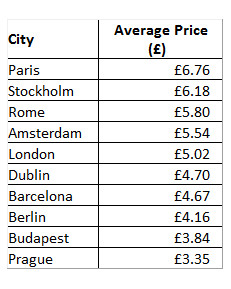
Anita Naik, Lifestyle Editor at VoucherCodes.co.uk, commented:
“Whether you have Irish connections or not, St. Patrick’s Day is one of the most popular excuses to visit your local and enjoy a cold Guinness or two with friends. However, it’s alarming to see that you could be paying almost double the price for your pint in the UK depending on where you choose to go out.
“It’s easy for a big day like Paddy’s Day to end up costing much more than anticipated. With prices varying so drastically across the country, it’s worth pre-planning and looking into the options in your local area before you head out to make sure you’re not spending more than necessary.
“VoucherCodes has lots of great deals at Wetherspoons and Greene King to help you save a bit of cash this Paddy’s Day, including a free £1 Amazon voucher. Visit https://www.vouchercodes.co.uk/guinness.com for our special Paddy’s Day code”
St Patrick’s Day in Nottingham!
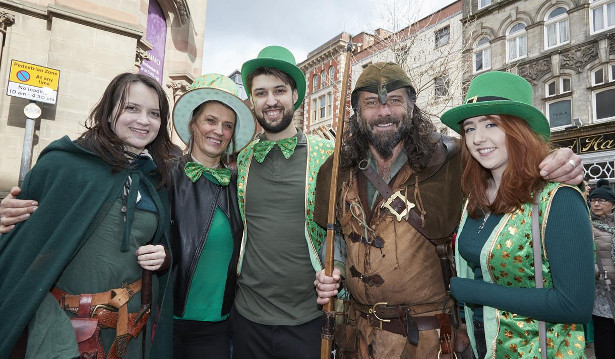
Tuesday 17 March 2020
Old Market Square
FREE event
The 21st annual Nottingham St Patrick’s Day event returns to the city centre.
Celebrating the city and region’s vibrant Irish community and descendants, which this year is presented in conjunction with Cork city and county.
Head to Old Market Square to enjoy a range of Irish and Irish-inspired live music and culture on stage including the John McNicholl Band. Plus stalls and traditional food and drink in what is in what is now the largest St Paddy’s celebration staged in the East Midlands. And of course, Riverdance is in town at The Royal Concert Hall between Monday 16 and Wednesday 18 March.
The Council House will also be going green as part of worldwide ‘global greening’.
CELEBRATE ST PATRICK’S DAY WITH AUTHENTIC IRISH GUINNESS RAMEN AT BIA REBEL RAMEN, BELFAST

Celebrate St Patrick’s Day this year with a Guinness Ramen at Bia Rebel Ramen, the award winning authentic Irish ramen restaurant and take-away in Belfast. Bia Rebel’s Guinness Ramen is chef Brian Donnelly’s take on Irish stew – swapping noodles for spuds. This delicious bowl of savoury goodness has hand-made noodles, Irish beef, buttered carrots and parsley and finally, the jewel in the crown of Irish products: Guinness. Chef Brian Donnelly has recreated the delicious creamy head — everyone’s favourite part of a pint of Guinness — by using a foam gun. (So ’90’s, we know.) “The resultant first bite tastes just like a pint, but then the foam melts into the broth giving it a light sweetness that coats the slurpy noodles. Perfect for setting you up for your big St Patrick’s Day night out.” says Bia Rebel co-owner Jenny Holland. Bia Rebel Guinness Ramen will be available until the end of March. Winners of the Observer Food Monthly Cheap Eats Award in 2018, Bia Rebel opened only a few months earlier in March 2018. With just 12 seats and take-away, locals, students and even Japanese families come in for fast, nourishing bowls of ramen.
Brian says: “We’re not trying to be a Japanese restaurant. We’re an Irish restaurant. It just so happens this wonderful, perfect dish we’re making is Japanese. And it’s a fantastic vehicle for great Irish ingredients.”
Press Release February 2020
ABOUT BRIAN DONNELLY Brian was born in 1974 in County Tyrone, known as the ‘murder triangle’ during the Troubles. The eldest of 7 children But he fell in love with the idea of being a chef after watching the Roux brothers on television in the 1980’s. Demonstrating early his willingness to hustle, he blagged his way into his first kitchen job aged just 13. After leaving secondary school he did a stint at catering college before picking up the phone to the prestigious Ballymaloe House. The timing was perfect, they were recruiting and he moved down to County Cork. Myrtle Allen, the founder of modern Irish cooking, took him under her wing and taught him how to recognise quality produce. From there he moved to London to work at Gary Rhodes’ Greenhouse, where he says he learned the confidence to cook English food. Hopping back and forth from London to Ireland he worked with Paul Rankin, Jean-Georges Vongerichten, Gordon Ramsey and Kevin Thornton. He thanks Vongerichten for teaching him technical perfection – ‘neater, tidier, quicker’. Brian and Jenny bought a food truck which they opened everyday at The Big Fish by Donegall Quay, before opening their permanent site on Ormeau Road in March 2018.k beyond white tablecloths and try to bridge the divide that keeps high-end products out of the mass market.
